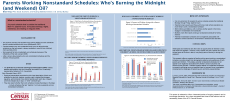
An official website of the United States government
Here’s how you know
Official websites use .gov
A .gov website belongs to an official government organization in the United States.
Secure .gov websites use HTTPS
A lock (
) or https:// means you’ve safely connected to the .gov website. Share sensitive information only on official, secure websites.
-
//
- Census.gov /
- Library /
- Census Working Papers /
- Parents Working Nonstandard Schedules: Who’s Burning the Midnight Oil?
Parents Working Nonstandard Schedules: Who's Burning the Midnight (and Weekend) Oil?
Parents Working Nonstandard Schedules: Who's Burning the Midnight (and Weekend) Oil?
Structural labor force changes in recent decades in both the temporal patterns of employment and women’s participation in paid work have led to a greater diversity of work-family arrangements. Fulfilling work and childrearing responsibilities has become more complex for families as the number of households in which both parents work outside the home has increased. Using Wave 1 of 2014 Survey of Income and Program Participation (SIPP), this study analyzes households with a parent working a nonstandard schedule. Respondents in the SIPP who are employed are asked to provide the best description of their current work schedule; possible responses include daytime schedule, evening shift, night shift, rotating shift (that changes regularly), split shift (consistently two distinct periods each day), irregular schedule (one that changes day to day), and an “other” response category. They are also asked to report which days of the week they typically work. Due to small sample sizes, I combine all of the non-daytime (and weekend) workers to analyze households in which at least one parent is working any nonstandard schedule. I find that parents who are in poverty or who have a high school degree or less are more likely to work a nonstandard schedule. Mothers are more likely than fathers to report working a nonstandard schedule for child care reasons. It is not uncommon for children to live with a parent working a nonstandard schedule. Although having a parent working a nonstandard schedule could potentially create scheduling conflicts, those children do not appear to have lower engagement in school or extracurricular activities compared to children whose parents don’t work a nonstandard schedule. This research highlights the challenges parents face in meeting the demands of work and family life in the context of labor market forces.
Share
Some content on this site is available in several different electronic formats. Some of the files may require a plug-in or additional software to view.
 Yes
Yes
 No
NoComments or suggestions?


Top

